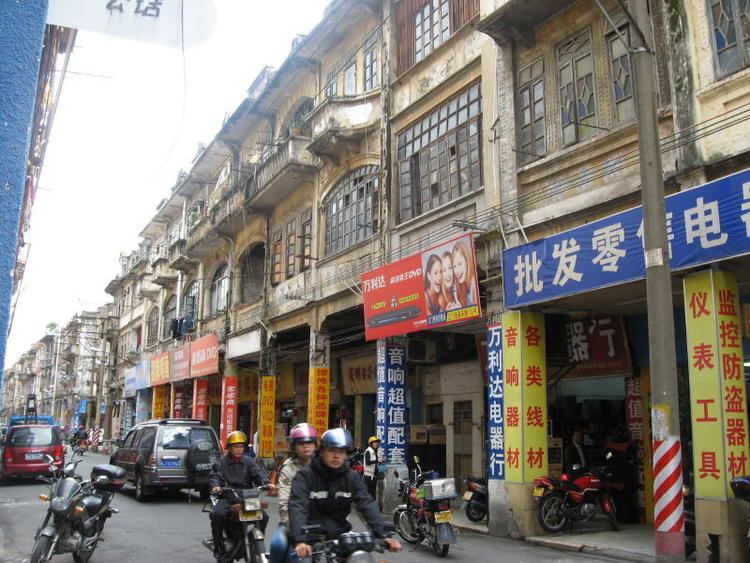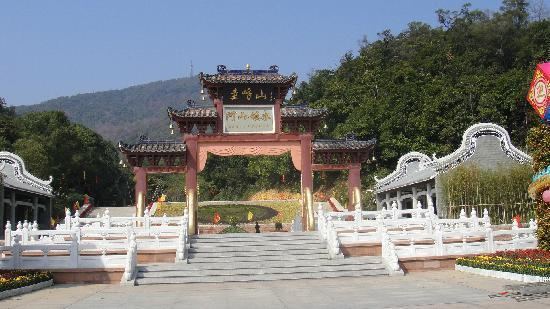Country China | Population 536,317 (2000) Area 9,443 km2 | |
 | ||
Map of Jiangmen
Jiangmen, formerly romanized in Cantonese as Kongmoon, is a prefecture-level city in Guangdong Province in southern China. Its 3 urban districts are now part of the Guangzhou–Shenzhen conurbation and the entire prefecture had a population of about 4.45 million in 2010.
Contents
- Map of Jiangmen
- Names
- History
- Geography
- Economy
- Manufacturing industries
- Uranium processing plant
- Jiangmen port
- Culture
- Tourism
- Education
- Transport
- References

Names

Jiangmen is the pinyin romanization of the Chinese name 江門 or 江门, based on its pronunciation in the Mandarin dialect. Its former Wade-Giles spelling was Chiang-men. The Postal Map spelling "Kongmoon" was based upon the same name's Cantonese pronunciation Gong¹-mun⁴. Other forms of the name include Kong Moon, Kongmun, and Kiangmoon. The name is often the butt of local jokes, since both Jiangmen and Gāngmén (肛門, 肛门), the scientific name for the anus, are pronounced identically as Gōngmùhn in Cantonese. This has led to proposals to change the name of the city, such as a 2009 campaign to rename it Qiáodū (t 僑都, s 侨都), "Capital of the Overseas Chinese", in honor of the region's contributions to the Chinese diaspora.

Jiangmen is also known as Pengjiang. Its rural hinterland is known to the Chinese diaspora as the "Four Counties" (q.v.), although the addition of Heshan to Jiangmen has prompted the remaining locals to begin calling it the "Five Counties" instead.
History

Historically, Jiangmen Town was a community under the administration of nearby Xinhui County. Jiangmen, however, was forced to open to western trade in 1902. A legacy of this period is a historic waterfront district lined with western-style buildings. The city has an ongoing renewal project which is restoring many of these buildings. Jiangmen was proclaimed a city in 1951 and later became the prefectural seat for the "Four County" region including Taishan, Kaiping, Xinhui, Enping. (In Mainland China but not abroad, the area became known as the "Five Counties" when Heshan was added to Jiangmen's jurisdiction.)

In 2011, the city banned pet dogs in public after rabies killed 42 people over the preceding 3 years. The city reserved a 13-acre site to allow rural Chinese to adopt the 30,000 dogs, but public outcry led to a softer implementation where violators would be told to leave rather than have the dog confiscated.
Geography
The city is located on the lower reaches of the Xijiang or West River, in the west of the Pearl River Delta in the middle of southern Guangdong Province. It faces the South China Sea in the south and is 100 kilometres (62 mi) away from Guangzhou and Zhuhai by highway. Jiangmen city has an area of 9,260 square kilometres (3,580 sq mi), about one quarter the size of the Pearl River Delta.
The climate is subtropical with monsoonal influences. The annual average temperature is 21.8 °C (71.2 °F).
Economy
Jiangmen was selected by the Chinese state as a pilot city for a nationwide information programme. It was also chosen by the Pacific Economic Cooperation Council (PECC) as a trial city for the Regional Integration for Sustainable Economics (RISE) project. According to the "Report on Investment Environment in China 2003" by the World Bank, Jiangmen ranked the fourth after Shanghai, Hangzhou and Dalian of 23 cities under evaluation in China. Among various indicators, Jiangmen excelled in infrastructure, labour redundancy, proportion of joint ventures in all firms, informal payments to government, taxation, productivity and the investment rate.
The economic development strategies within Jiangmen focus on the three urban districts, and the south, middle and north lines. It is planned to develop four main economic areas: the central urban district of the city, the Yinzhou Lake (銀州湖) economic area, and two economic areas along the various transport axes.
Manufacturing industries
Similar to other cities in the western Pearl River Delta, the manufacturing sector plays a significant role in Jiangmen's economy. The chief industries include manufacturing of motorcycles, household appliances, electronics, paper, food processing, synthetic fibers and garments, as well as textiles and stainless steel products. Some worldwide brand names have factories in Jiangmen such as Asia Pacific Resources International Holdings, ABB Group and Lee Kum Kee foods.
Uranium processing plant
The city was the proposed site of a $6.5 billion, 40 billion renminbi, uranium processing plant which would have supplied about half of the enriched uranium needed by China's nuclear power plants. Announcement of the plant in July 2013 was met by public protests. The proposal was withdrawn out of "respect for public opinion" shortly thereafter.
Jiangmen port
Jiangmen Port is the second largest river port in Guangdong province. The local government plans to develop a harbour industrial zone with heavy industries to include petrochemical and machinery plants, as well as an ocean-based economy.
Culture
Jiangmen is the homeland of 3.68 million overseas Chinese, who live in 107 countries and regions throughout the world. Strong oversea connections are especially found in the villages.
Tourism
A significant amount of historical heritage survives from the period of mass emigration prior to World War II. The most significant are the fortified multi-story towers found mainly in Kaiping. These are known as "Gold Mountain Towers" or diaolou. A number of natural hotspring resorts has been developed successfully by using its wealthy natural heated ground water resources such as Gudou Hotspring Resort (古兜温泉). Guifeng Mountain, a mountain visited by many tourists, is the peak of Jiangmen with an elevation of 545 meters above sea level.
The local government's economic development strategies emphasize the development of tourism and protection of the environment.
Education
Wuyi University is the main university in Jiangmen.
The only international school in Jiangmen is Boren Sino-Canadian School, while bilingual schools include WuYi Country Garden Bilingual School and China-Hong Kong English School.
Jiangmen Polytechnic College, located at Chaolian Island, enrolls about 13,000 students in various technical and humanities programs.
Jiangmen No. 1 Middle School is claimed to be the top middle school in the district. It used to be one of the best middle schools in Guangdong Province in the 1980s and 1990s. However, the quality of its education has been dropping in recent years and within the district of Jiangmen, its status is being constantly challenged by schools such as Xinhui No. 1 Middle School in Xinhui, Kaiqiao (Kaiping Emigrant) Middle School in Kiaping and Heshan No.1 Middle School in Heshan.
Transport
Jiangmen has a mature network of inter-city highway (between Guangzhou, Foshan, Zhuhai, Zhongshan, Yangjiang etc.). It sits astride a key route between Guangzhou and the southwest region of its home province, and also Guangxi Province.
A network of intra-city roadways has been built since the late 1990s to facilitate industrial integration within the city.
Railways came to Jiangmen fairly recently. The city is served by the Xinhui branch of the Guangzhou–Zhuhai Intercity Mass Rapid Transit (opened 2011), which provides frequent service to Guangzhou South Railway Station, where connections to the nation's high-speed railway network are available. Since the late 2012, Jiangmen is also served by the freight-only Guangzhou–Zhuhai Railway.
Making use of the Jiangmen Port facilities, Chu Kong Passenger Transport (CKS) connects Jiangmen with high speed ferry services to Hong Kong (95 nautical miles) taking about 2.5 hours each way.
